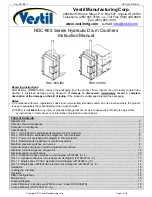
SECTION 4 -- LUBRICATION AND MAINTENANCE
4--4
FUEL REQUIREMENTS
The quality of fuel used is an important factor for
dependable performance and satisfactory engine
life. Fuels must be clean, well-refined, and
non-corrosive to fuel system parts. Be sure to use
fuel of a known quality from a reputable supplier.
Use Number 2-D in temperatures above --7
°
C (20
°
F).
Use Number 1-D in temperatures below --7
°
C (20
°
F).
To obtain optimum combustion and minimum engine
wear, the fuel selected for use should conform to the
application and property requirements outlined in the
following chart.
DIESEL FUEL SELECTION CHART
General Fuel
Classification
Final
Boiling
Point(Max)
Cetane
Rating
(Min)
Sulphur
Content
(Max)
No. 1--D
288
° ⊂
(550
°
F)
40*
0.3%
No. 2--D
357
°
C
(675
°
F)
40
0.5%
NOTE:
When long periods of idling or cold weather
conditions below 0
°
C (32
°
F) are encountered or
when continuously operating at an altitude above
5,000 ft
.
(1500 m) use Number 1-D fuel.
*
When continually operating at low temperatures or
high altitude, a minimum cetane rating of 45 is
required.
Using diesel fuel with sulphur content above 0.5%
requires more frequent oil and filter changes as
noted in the maintenance schedule.
The use of diesel fuel with a sulphur content above
1.3% is not recommended.
For the best fuel economy, use Number 2--D fuel
whenever temperatures allow.
Do not use Number 2-D fuel at temperatures below
--7
°
C (20
°
F). The cold temperatures will cause the
fuel to thicken, which may prevent the engine from
running. (If this happens, contact your dealer.)
To be sure that a fuel meets the required properties,
enlist the aid of a reputable fuel oil supplier. The
responsibility for clean fuel lies with the fuel supplier
as well as the fuel user.
FUEL STORAGE
Take the following precautions to ensure that stored
fuel is kept free of dirt, water and other contaminants.
•
Store fuel in black iron tanks, not galvanized
tanks, as the zinc coating will react with the fuel
and form compounds that will contaminate the
injection pump and injectors.
•
Install bulk storage tanks away from direct
sunlight and angle them slightly so sediment in
the tanks will settle away from the outlet pipe.
•
To facilitate moisture and sediment removal,
provide a drain plug at the lowest point at the end
opposite the outlet pipe.
•
If fuel is not filtered from the storage tank, put a
funnel with a fine mesh screen in the fuel tank
filler neck when refuelling.
•
Arrange fuel purchases so summer grade fuels
are not held over and used in winter.
Summary of Contents for T6010 DELTA
Page 1: ...OPERATOR S MANUAL T6010 T6020 T6030 T6050 T6070 Delta and Plus Tractors ...
Page 6: ...BLANK ...
Page 28: ...SECTION 1 GENERAL INFORMATION AND SAFETY 1 22 NOTES ...
Page 280: ...SECTION 3 FIELD OPERATION 3 146 NOTES ...
Page 366: ...SECTION 5 FAULT FINDING 5 12 NOTES ...
Page 368: ...SECTION 6 VEHICLE STORAGE 6 2 NOTES ...
Page 400: ...SECTION 8 SPECIFICATIONS 8 24 NOTES ...
Page 402: ...SECTION 9 1ST 50 HOUR SERVICE SHEETS 9 2 ...
Page 404: ...SECTION 9 1ST 50 HOUR SERVICE SHEETS 9 4 ...
Page 410: ...SECTION 10 INDEX 10 6 ...
Page 412: ...sblank ...
















































